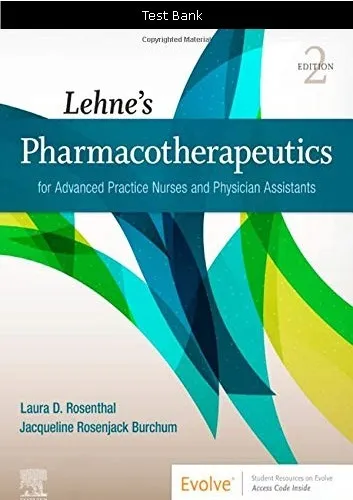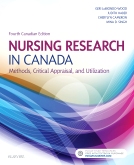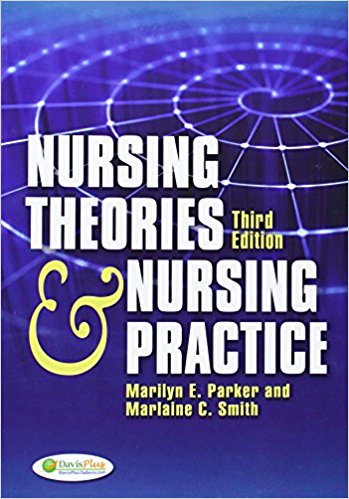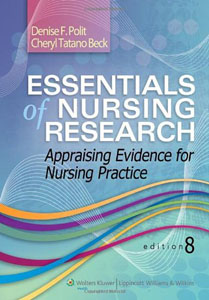Lehne’s Pharmacotherapeutics for Advanced Practice Nurses and Physician Assistants 2nd Ed. Test Bank
$55.00 Original price was: $55.00.$24.00Current price is: $24.00.
Digital item No Waiting Time Instant Download
Chapters: 92
Format: PDF
ISBN-13: 978-0323554954
ISBN-10: 0323554954
Publisher: Saunders
Authors: Laura Rosentha, Jacqueline Burchum
Description
Lehne’s Pharmacotherapeutics for Advanced Practice Nurses and Physician Assistants 2nd Ed. Test Bank
Table of Contents
UNIT I: INTRODUCTION
1. Prescriptive Authority
2. Rational Drug Selection and Prescription Writing
3. Promoting Positive Outcomes of Drug Therapy
UNIT II: BASIC PRINCIPLES OF PHARMACOLOGY
4. Pharmacokinetics, Pharmacodynamics, and Drug Interactions
5. Adverse Drug Reactions and Medication Errors
6. Individual Variation in Drug Responses
7. Genetic and Genomic Considerations in Pharmacotherapeutics NEW!
UNIT III: DRUG THERAPY ACROSS THE LIFE SPAN
8. Drug Therapy During Pregnancy and Breast-Feeding
9. Drug Therapy in Pediatric Patients
10. Drug Therapy in Geriatric Patients
UNIT IV: PERIPHERAL NERVOUS SYSTEM DRUGS
11. Basic Principles of Neuropharmacology
12. Physiology of the Peripheral Nervous System 13. Muscarinic Agonists
14. Muscarinic Antagonists NEW!
15. Adrenergic Agonists
16. Adrenergic Antagonists 17. Indirect-Acting Antiadrenergic Agents
UNIT V: CENTRAL NERVOUS SYSTEM DRUGS 18. Introduction to Central Nervous System Pharmacology
19. Drugs for Parkinson Disease
20. Drugs for Alzheimer Disease
21. Drugs for Seizure Disorders
22. Drugs for Muscle Spasm and Spasticity
UNIT VI: DRUGS FOR PAIN 23. Local Anesthetics
24. Opioid Analgesics, Opioid Antagonists, and Nonopioid Centrally Acting Analgesics 25. Drugs for Headache
UNIT VII: PSYCHOTHERAPEUTIC DRUGS
26. Antipsychotic Agents and Their Use in Schizophrenia 27. Antidepressants
28. Drugs for Bipolar Disorder 29. Sedative-Hypnotic Drugs 30. Management of Anxiety Disorders
31. Central Nervous System Stimulants and Attention-Deficit/Hyperactivity Disorder
UNIT VIII: SUBSTANCE USE DISORDERS
32. Substance Use Disorders I: Basic Considerations
33. Substance Use Disorders II: Alcohol
34. Substance Use Disorders III: Nicotine and Smoking
35. Substance Use Disorders IV: Major Drugs of Abuse Other Than Alcohol and Nicotine
UNIT IX: DRUGS THAT AFFECT THE HEART, BLOOD VESSELS, BLOOD, AND BLOOD VOLUME
36. Review of Hemodynamics 37. Diuretics
38. Drugs Acting on the Renin-Angiotensin-Aldosterone System
39. Calcium Channel Blockers 40. Vasodilators
41. Drugs for Hypertension 42. Drugs for Heart Failure 43. Antidysrhythmic Drugs 44. Prophylaxis of Atherosclerotic Cardiovascular Disease: Drugs That Help Normalize Cholesterol and Triglyceride Levels
45. Drugs for Angina Pectoris 46. Anticoagulant, Antiplatelet, and Thrombolytic Drugs
47. Drugs for Deficiency Anemias
UNIT X: DRUGS FOR ENDOCRINE DISORDERS 48. Drugs for Diabetes Mellitus
49. Drugs for Thyroid Disorders
UNIT XI: WOMEN’S HEALTH
50. Estrogens and Progestins: Basic Pharmacology and Noncontraceptive Applications 51. Birth Control
UNIT XII: MEN’S HEALTH 52. Androgens
53. Drugs for Erectile Dysfunction and Benign Prostatic Hyperplasia
UNIT XIII: ANTI-INFLAMMATORY, ANTIALLERGIC, AND IMMUNOLOGIC DRUGS
54. Review of the Immune System
55. Childhood Immunization 56. Antihistamines
57. Cyclooxygenase Inhibitors: Nonsteroidal Anti-inflammatory Drugs and Acetaminophen
58. Glucocorticoids in Nonendocrine Disorders
UNIT XIV: DRUGS FOR BONE AND JOINT DISORDERS
59. Drug Therapy of Rheumatoid Arthritis
60. Drug Therapy of Gout
61. Drugs Affecting Calcium Levels and Bone Mineralization
UNIT XV: RESPIRATORY TRACT DRUGS
62. Drugs for Asthma and Chronic Obstructive Pulmonary Disease
63. Drugs for Allergic Rhinitis, Cough, and Colds
UNIT XVI: GASTROINTESTINAL DRUGS
64. Drugs for Peptic Ulcer Disease
65. Laxatives
66. Other Gastrointestinal Drugs
UNIT XVII: NUTRITION AND COMPLIMENTARY THERAPIES
67. Vitamins
68. Drugs for Weight Loss
69. Complementary and Alternative Therapies
UNIT XIII: THERAPY OF INFECTIOUS AND PARASITIC DISEASES
70. Basic Principles of Antimicrobial Therapy
71. Drugs That Weaken the Bacterial Cell Wall I: Penicillins
72. Drugs That Weaken the Bacterial Cell Wall II: Other Drugs
73. Bacteriostatic Inhibitors of Protein Synthesis
74. Aminoglycosides: Bactericidal Inhibitors of Protein Synthesis
75. Sulfonamides and Trimethoprim
76. Drug Therapy of Urinary Tract Infections
77. Drugs Therapy for Tuberculosis
78. Miscellaneous Antibacterial Drugs
79. Antifungal Agents
80. Antiviral Agents I: Drugs for Non-HIV Viral Infections 81. Antiviral Agents II: Drugs for HIV Infection and Related Opportunistic Infections
82. Drug Therapy of Sexually Transmitted Diseases
83. Anthelmintics, Antiprotozoal Drugs, and Ectoparasiticides
UNIT XIX: CANCER THERAPY
84. Introduction to Immunomodulators NEW!
85. Supportive Care of Patients Receiving Anticancer Drugs
86. Drugs for Cancer Pain
UNIT XX: Drugs for Eyes, Ears, and Skin
87. Drugs for the Eye
88. Drugs for the Skin
89. Drugs for the Ear
UNIT XXI: DRUG THERAPY IN ACUTE CARE
90. Agents Affecting the Volume and Ion Content of Body Fluids
91. Management of ST-Elevation Myocardial Infarction
92. Additional Acute Care Drugs
APPENDIX: Canadian Drug Information
Index
LEHNE’S PHARMACOTHERAPEUTICS FOR ADVANCED PRACTICE NURSES AND
PHYSICIAN ASSISTANTS 2ND EDITION ROSENTHAL TEST BANK
Chapter 1: Prescriptive Authority
Test Bank
Multiple Choice
1. An APRN works in a urology clinic under the supervision of a physician who does not restrict
the types of medications the APRN is allowed to prescribe. State law does not require the
APRN to practice under physician supervision. How would the APRN’s prescriptive authority
be described?
a. Full authority
b. Independent
c. Without limitation
d. Limited authority
ANS: B
The APRN has independent prescriptive authority because the regulating body does not require
that the APRN work under physician supervision. Full prescriptive authority gives the provider
the right to prescribe independently and without limitation. Limited authority places restrictions
on the types of drugs that can be prescribed.DIF: Cognitive Level: ComprehensionREF: p. 1TOP:
Nursing Process: I MSC: NCLEX Client Needs Category: Physiologic Integrity: Pharmacologic
and Parenteral Therapies
2. Which factors increase the need for APRNs to have full prescriptive authority?
a. More patients will have access to health care.
b. Enrollment in medical schools is predicted to decrease.
c. Physician’s assistants are being utilized less often.
d. APRN education is more complex than education for physicians.
ANS: A
Implementation of the Affordable Care Act has increased the number of individuals with health
care coverage, and thus the number who have access to health care services. The increase in the
number of patients creates the need for more providers with prescriptive authority. APRNs can fill
this practice gap.DIF: Cognitive Level: ComprehensionREF: p. 2TOP: Nursing Process:
Implementation MSC: NCLEX Client Needs Category: Physiologic Integrity: Pharmacologic and
Parenteral Therapies
3. Which factors could be attributed to limited prescriptive authority for APRNs?
Select all that apply.
a. Inaccessibility of patient care
b. Higher health care costs
c. Higher quality medical treatment
d. Improved collaborative care
e. Enhanced health literacy
ANS: A , B
Limiting prescriptive authority for APRNs can create barriers to quality, affordable, and accessible
patient care. It may also lead to poor collaboration among providers and higher health care costs.
It would not directly impact patient’s health literacy.DIF: Cognitive Level: ComprehensionREF:
p. 2TOP: Nursing Process: Implementation MSC: NCLEX Client Needs Category: Physiologic
Integrity: Pharmacologic and Parenteral Therapies
4. Which aspects support the APRN’s provision for full prescriptive authority?
Select all that apply.
a. Clinical education includes prescription of medications and disease processes.
b. Federal regulations support the provision of full authority for APRNs.
c. National examinations provide validation of the APRN’s ability to provide safe care.
d. Licensure ensures compliance with health care and safety standards.
e. Limiting provision can decrease health care affordability.
ANS: A , C , D
APRNs are educated to practice and prescribe independently without supervision. National
examinations validate the ability to provide safe and competent care. Licensure ensures
compliance with standards to promote public health and safety. Limited prescriptive authority
creates numerous barriers to quality, affordable, and accessible patient care.DIF: Cognitive Level:
ComprehensionREF: pp. 1-2TOP: Nursing Process: Implementation MSC: NCLEX Client Needs
Category: Physiologic Integrity: Pharmacologic and Parenteral Therapies
5. Which aspects support the APRN’s provision for full prescriptive authority?
Select all that apply.
a. Clinical education includes prescription of medications and disease processes.
b. Federal regulations support the provision of full authority for APRNs.
c. National examinations provide validation of the APRN’s ability to provide safe care.
d. Licensure ensures compliance with health care and safety standards.
ANS: A , C , D
APRNs are educated to practice and prescribe independently without supervision. National
examinations validate the ability to provide safe and competent care. Licensure ensures
compliance with standards to promote public health and safety. Limited prescriptive authority
creates numerous barriers to quality, affordable, and accessible patient care.DIF: Cognitive Level:
ComprehensionREF: pp. 1-2TOP: Nursing Process: Implementation MSC: NCLEX Client
Needs Category: Physiologic Integrity: Pharmacologic and Parenteral Therapies
6. A family nurse practitioner practicing in Maine is hired at a practice across state lines in
Virginia. Which aspect of practice may change for the APRN?
a. The APRN will have less prescriptive authority in the new position.
b. The APRN will have more prescriptive authority in the new position.
c. The APRN will have equal prescriptive authority in the new position.
d. The APRN’s authority will depend on federal regulations.
ANS: A
Virginia allows limited prescriptive authority, while Maine gives full authority to certified nurse
practitioners. The federal government does not regulate prescriptive authority.DIF: Cognitive
Level: ComprehensionREF: p. 3TOP: Nursing Process: Implementation MSC: NCLEX Client
Needs Category: Physiologic Integrity: Pharmacologic and Parenteral Therapies
Rosenthal: Lehne’s Pharmacotherapeutics for Advanced Practice Providers, 2nd Ed.
Chapter 2: Rational Drug Selection and Prescription Writing
Test Bank
Multiple Choice
7. How can collaboration with a pharmacist improve positive outcomes for patients?
Select all that apply.
a. Pharmacists can suggest foods that will help with the patient’s condition.
b. Pharmacists have additional information on drug interactions.
c. The pharmacist can suggest adequate medication dosing.
d. Pharmacists have firsthand knowledge of the facility formulary.
e. Pharmacy can alter prescriptions when necessary to prevent patient harm.
ANS: B , C , D
Providers should collaborate with pharmacists because they will likely have additional information
on formulary, drug interactions, and suggestions for adequate medication dosing. Dietitians can
make foods recommendations to treat the patient’s condition. The pharmacist can contact the
prescriber about questionable prescriptions, but cannot alter the prescription without notification
of and approval by the provider.DIF: Cognitive Level: ComprehensionREF: p. 9TOP: Nursing
Process: Diagnosis MSC: NCLEX Client Needs Category: Physiologic Integrity: Reduction of
Risk Potential





Be the first to review “Lehne’s Pharmacotherapeutics for Advanced Practice Nurses and Physician Assistants 2nd Ed. Test Bank”